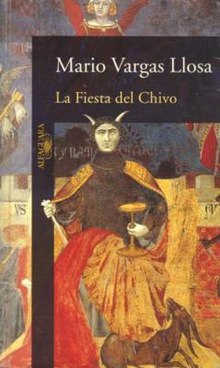La Fiesta del Chivo

First edition (Spanish)
|
|
| Author | Mario Vargas Llosa |
|---|---|
| Original title | La fiesta del chivo |
| Translator | Edith Grossman |
| Country | Peru |
| Language | Spanish |
| Genre | Historical novel Dictator novel |
| Publisher |
Alfaguara (Spanish) Picador (imprint) (English) |
|
Publication date
|
2000 |
|
Published in English
|
2001 |
| Media type | Print (hardback & paperback) |
| ISBN | (Spanish) (English) |
The Feast of the Goat (Spanish: La fiesta del chivo, 2000) is a novel by the Peruvian Nobel Prize in Literature laureate Mario Vargas Llosa. The book is set in the Dominican Republic and portrays the assassination of Dominican dictator Rafael Trujillo, and its aftermath, from two distinct standpoints a generation apart: during and immediately after the assassination itself, in May 1961; and thirty five years later, in 1996. Throughout, there is also extensive reflection on the heyday of the dictatorship, in the 1950s, and its significance for the island and its inhabitants.
The novel follows three interwoven storylines. The first concerns a woman, Urania Cabral, who is back in the Dominican Republic, after a long absence, to visit her ailing father; she ends up recalling incidents from her youth and recounting a long-held secret to her aunt and cousins. The second story line focuses on the last day in Trujillo's life from the moment he wakes up onwards, and shows us the regime's inner circle, to which Urania's father once belonged. The third strand depicts Trujillo's assassins, many of whom had previously been government loyalists, as they wait for his car late that night; after the assassination, this story line shows us the assassins' persecution. Each aspect of the book's plot reveals a different viewpoint on the Dominican Republic's political and social environment, past and present.
Readers are shown the regime's downward spiral, Trujillo's assassination, and its aftermath through the eyes of insiders, conspirators, and a middle-aged woman looking back. The novel is therefore a kaleidoscopic portrait of dictatorial power, including its psychological effects, and its long-term impact. The novel's themes include the nature of power and corruption, and their relationship to machismo and sexual perversion in a rigidly hierarchical society with strongly gendered roles. Memory, and the process of remembering, is also an important theme, especially in Urania's narrative as she recalls her youth in the Dominican Republic. Her story (and the book as a whole) ends when she recounts the terrible events that led to her leaving the country at the age of 14. The book itself serves as a reminder of the atrocities of dictatorship, to ensure that the dangers of absolute power will be remembered by a new generation.
Vargas Llosa interlaces fictional elements and historical events: the book is not a documentary, and the Cabral family, for instance, is completely fictional. On the other hand, the characters of Trujillo and Trujillo's assassins are drawn from the historical record; Vargas Llosa weaves real historical incidents of brutality and oppression into these people's stories, to further illuminate the nature of the regime and the responses it provoked. In Vargas Llosa's words, "It's a novel, not a history book, so I took many, many liberties. [. . .] I have respected the basic facts, but I have changed and deformed many things in order to make the story more persuasive—and I have not exaggerated."
...
Wikipedia
